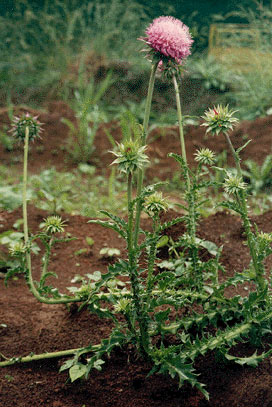
Carduus nutans, with the common names musk thistle, nodding thistle, and nodding plumeless thistle, is a biennial plant in the daisy and sunflower family Asteraceae. It is native to regions of Eurasia.

Leucanthemum vulgare, commonly known as the ox-eye daisy, oxeye daisy, dog daisy, marguerite and other common names, is a widespread flowering plant native to Europe and the temperate regions of Asia, and an introduced plant to North America, Australia and New Zealand.

Cotinus, the smoketree or smoke bush, is a genus of seven species of flowering plants in the family Anacardiaceae, closely related to the sumacs (Rhus).
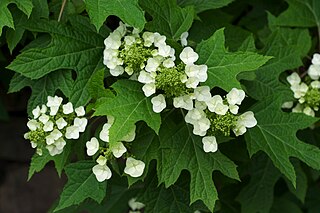
Hydrangea quercifolia, commonly known as oakleaf hydrangea or oak-leaved hydrangea, is a species of flowering plant in the family Hydrangeaceae. It is native to the southeastern United States, in woodland habitats from North Carolina west to Tennessee, and south to Florida and Louisiana. A deciduous shrub with white showy flower heads, it is grown as a garden plant, with numerous cultivars available commercially.

Ribes sanguineum, the flowering currant, redflower currant, red-flowering currant, or red currant is a North American species of flowering plant in the family Grossulariaceae, native to the western United States and Canada.

Viola sororia, known commonly as the common blue violet, is a short-stemmed herbaceous perennial plant that is native to eastern North America. It is known by a number of common names, including common meadow violet, purple violet, woolly blue violet, hooded violet, and wood violet. Its cultivar 'Albiflora' has gained the Royal Horticultural Society's Award of Garden Merit. This perennial plant species is distributed in the eastern half of the United States, Canada and a part of Eastern Mexico. Their native habitats are rich, moist woods, and swamps located in the eastern half of the United States and Canada.

Hakea purpurea is a flowering plant in the family Proteaceae shrub and grows in Queensland and New South Wales. It is a small shrub with needle-shaped leaves and clusters of red flowers in late winter to early spring.
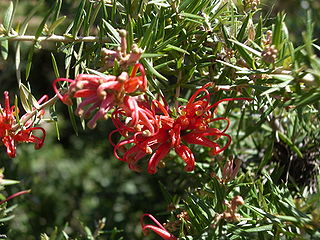
Grevillea juniperina, commonly known as juniper- or juniper-leaf grevillea or prickly spider-flower, is a plant of the family Proteaceae native to eastern New South Wales and southeastern Queensland in Australia. Scottish botanist Robert Brown described the species in 1810, and seven subspecies are recognised. One subspecies, G. j. juniperina, is restricted to Western Sydney and environs and is threatened by loss of habitat and housing development.

Tecoma stans is a species of flowering perennial shrub in the trumpet vine family, Bignoniaceae, that is native to the Americas. Common names include yellow trumpetbush, yellow bells, yellow elder, ginger Thomas. Tecoma stans is the official flower of the United States Virgin Islands and the floral emblem of The Bahamas.

Ipomoea indica is a species of flowering plant in the family Convolvulaceae, known by several common names, including blue morning glory, oceanblue morning glory, koali awa, and blue dawn flower. It bears heart-shaped or 3-lobed leaves and purple or blue funnel-shaped flowers 6–8 cm (2–3 in) in diameter, from spring to autumn. The flowers produced by the plant are hermaphroditic. This plant has gained the Royal Horticultural Society's Award of Garden Merit.
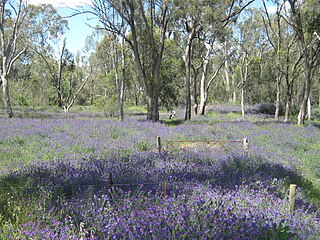
Paterson's curse is an invasive plant species in Australia. The name Salvation Jane originated from, and is mostly used in, South Australia due to its use as a source of food for grazing animals when the less drought-tolerant grazing pastures die off. Other names are blueweed, Lady Campbell weed, Riverina bluebell, and purple viper's bugloss.

Verbascum blattaria, the moth mullein, is a flowering biennial plant belonging to the figwort family Scrophulariaceae. A native of Eurasia and North Africa, it has naturalized in the United States and most of Canada since its introduction and has become an invasive species there. It has been declared a noxious weed by the state of Colorado.

Gazania rigens, sometimes called treasure flower, is a species of flowering plant in the family Asteraceae, native to coastal areas of southern Africa. It is naturalised elsewhere and is widely cultivated as an ornamental plant.
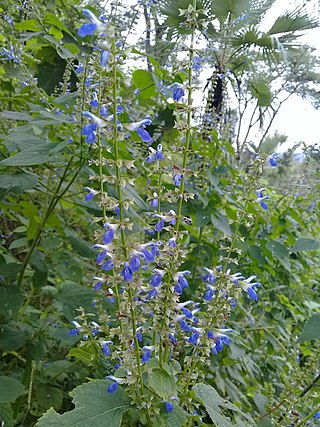
Salvia longispicata is a perennial shrub native to southwestern Mexico, growing between 1,000 and 6,500 feet elevation. The specific epithet "longispicata" gives the impression that the plant has "long spikes", but instead refers to the many projecting clusters of short flowering spikes that resemble small ears of corn.
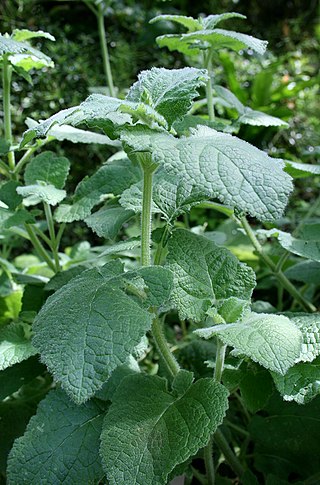
Salvia przewalskii is a herbaceous perennial plant native to the Chinese provinces of Gansu, Hubei, Sichuan, Xizang, and Yunnan, typically growing along stream banks, forest edges, among shrubs, and on granitic hillsides. It was described and named in 1881 by the Russian botanist Carl Maximowicz after the Russian explorer and botanist Nikolai Przhevalsky, who made several collecting trips to China in the 19th century. The plant is widely known throughout its native habitat for its medicinal properties.
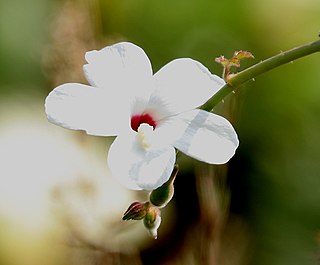
Abelmoschus ficulneus is a species of flowering plant in the genus Abelmoschus, family Malvaceae. Commonly known as white wild musk mallow or native rosella, it is fibrous perennial with a woody stem. Its flowers are about an inch in diameter, either pink or white, with a rose center; its leaves are palmate.
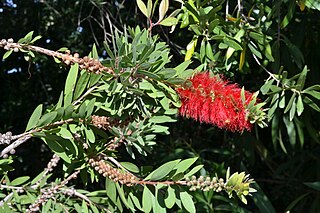
Melaleuca citrina, the common red bottlebrush, crimson bottlebrush, or lemon bottlebrush, is a plant in the myrtle family Myrtaceae, and is endemic to eastern Australia. Some Australian state herbaria continue to use the name Callistemon citrinus. It is a hardy and adaptable species, common in its natural habitat. It is widely cultivated, not only in Australia. It was one of the first Australian plants to be grown outside the country, having been taken to England in 1770 by Joseph Banks. Its showy red flower spikes, present over most of the year in an ideal situation, account for its popularity.

Alternanthera brasiliana, also known as large purple alternanthera, metal weed, bloodleaf, parrot leaf, ruby leaf, Brazilian joyweed, purple alternanthera, purple joyweed, is a flowering plant of the amaranth family that is native to the forests of South America and as well as Central America. Grown as an ornamental plant, it is very similar in appearance to Alternanthera dentata, which is listed as one of this species's synonyms.

Cheiranthera linearis, commonly known as finger-flower, is a flowering plant in the family Pittosporaceae. It is a small shrub with deep purple flowers, yellow stamens and dull green linear shaped leaves. It is found growing in New South Wales, Victoria and Queensland.

Pomaderris adnata is a spreading shrub in the family Rhamnaceae, it is endemic to New South Wales. It has smooth, elliptic or oblanceolate green leaves and pale yellow flowers in spring.






















